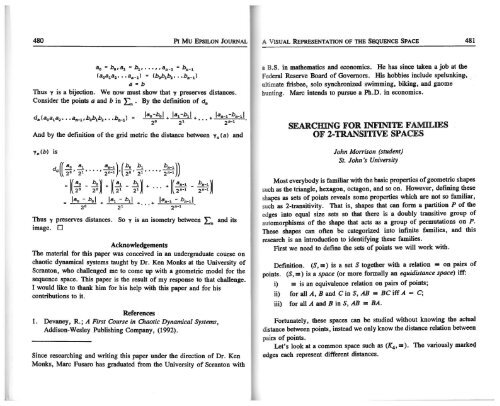Vol. 10 No 6 - Pi Mu Epsilon
Vol. 10 No 6 - Pi Mu Epsilon
Vol. 10 No 6 - Pi Mu Epsilon
- No tags were found...
Create successful ePaper yourself
Turn your PDF publications into a flip-book with our unique Google optimized e-Paper software.
480 PI MU EPSILON JOURNAL<br />
A VISUAL REPRESENTATION OF THE SEQUENCE SPACE 481<br />
a0: b0,a1: b11' ''I ,aD-1: bD-1<br />
Caoa1a2 • • • an-1> = Cbob1b2 • • .bn-1><br />
a=b<br />
Thus y is a bijection. We now must show that y preserves distances.<br />
Consider the points a and b in En . By the definition of d 12<br />
a B.S. in mathematics and economics. He has since taken a job at the<br />
Federal Reserve Board of Governors. His bobbies include spelunkif!g-,<br />
ultimate frisbee, solo synchronized swimming, biking, and gnome<br />
bunting. Marc intends to pursue a Ph.D. in economics.<br />
And by the definition of the grid metric the distance between y n (a) and<br />
Yn(b) is<br />
1<br />
dG (( ;~ ' ;~ , • • • , ;:=~) ( ~~<br />
,<br />
~~<br />
,<br />
•• , , ~:=~))<br />
= I( ;~ - ~~)I + I( ;~ - ~~)I + .. • + I( ;:=~ - ~:=~)I<br />
= lao - bol + la1 - b1l + + lan-1 - bn-1l<br />
20 21 · ' ' 2 n-1<br />
Thus y preserves distances. So y is an isometry between En and its<br />
image. 0<br />
Acknowledgements<br />
The material for this paper was conceived in an undergraduate course on<br />
chaotic dynamical systems taught by Dr. Ken Monks at the University of<br />
Scranton, who challenged me to come up with a geometric model for the<br />
sequence space. This paper is the result of my response to that challenge.<br />
I would like to thank him for his help with this paper and for his<br />
contributions to it.<br />
References<br />
1. Devaney, R.; A First Course in Chaotic Dynamical Systems,<br />
Addison-Wesley Publishing Company, (1992).<br />
Since researching and writing this paper under the direction of Dr. Ken<br />
Monks, Marc Fusaro has graduated from the University of Scranton with<br />
SEARCmNG FOR INFINITE FAMILIES<br />
OF 2-TRANSITIVE SPACES<br />
John Morrison (student)<br />
St. John's University<br />
Most everybody is familiar with the basic properties of geometric shapes<br />
such as the triangle, hexagon, octagon, and so on. However, defining these<br />
shapes as sets of points reveals some properties which are not so familiar,<br />
such as 2-transitivity. That is, shapes that can form a partition P of the<br />
edges into equal size sets so that there is a doubly transitive group of<br />
automorphisms of the shape that acts as a group of permutations on P.<br />
These shapes can often be categorized into infinite families, and this<br />
research is an introduction to identifying these families.<br />
First we need to define the sets of points we will work with.<br />
Definition. (S, =) is a set S together with a relation = on pairs of<br />
points. {S, =) is a space (or more formally an equidistance space) iff:<br />
i) = is an equivalence relation on pairs of points;<br />
ii) for all A, Band C inS, AB !!! BC iff A = C;<br />
iii)<br />
for all A and B in S, AB = BA.<br />
Fortunately, these spaces can be studied without knowing the actual<br />
distance between points, instead we only know the distance relation between<br />
pairs of points.<br />
Let's look at a common space such as (K 4 , =). The variously marke4<br />
edges each represent different distances.
















